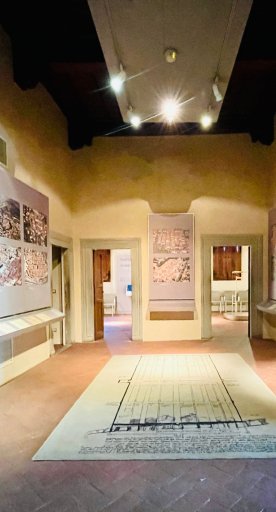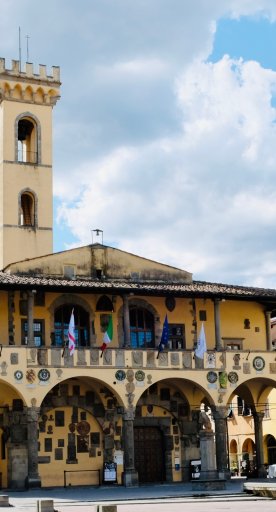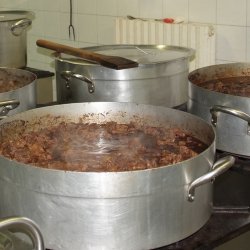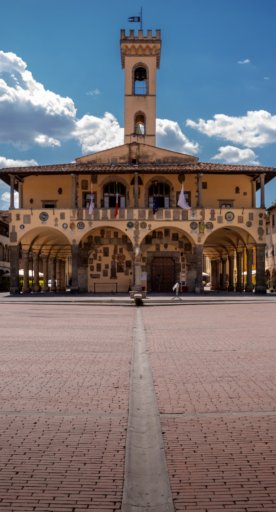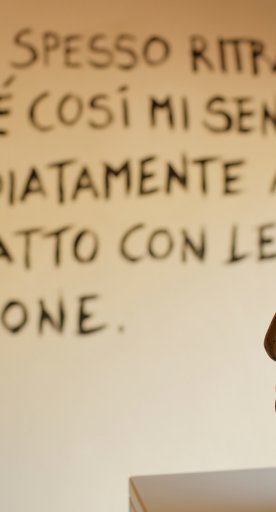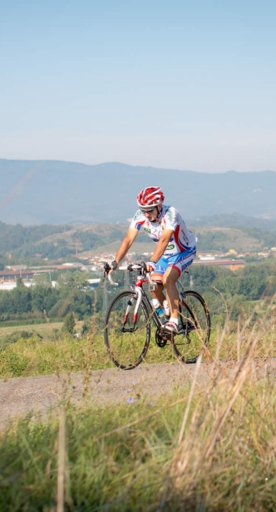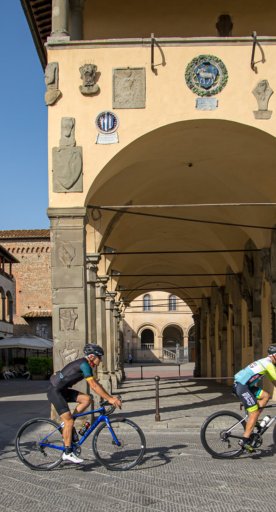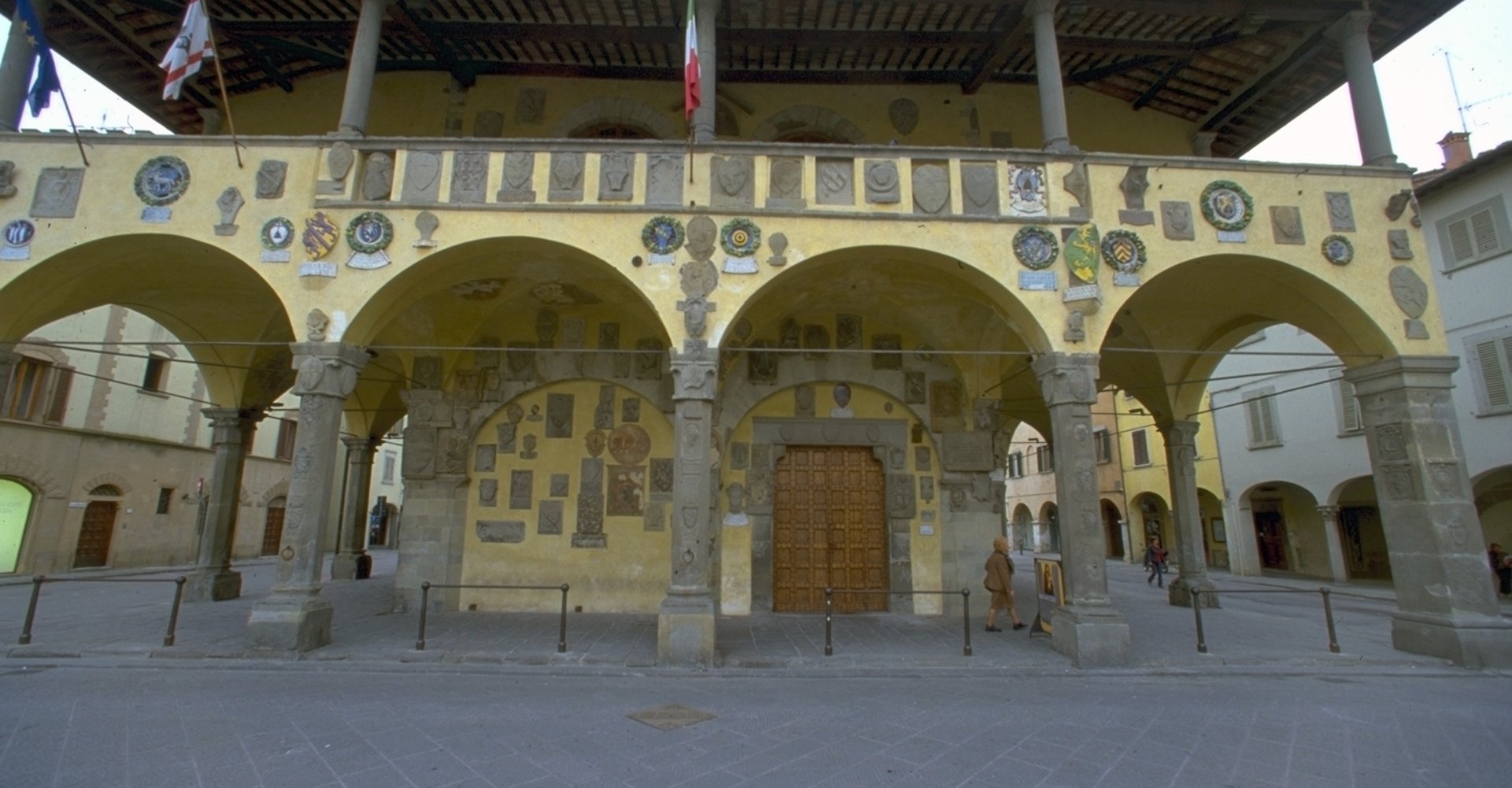
San Giovanni Valdarno
A village in the Arezzo area with a wealth of artistic heritage
San Giovanni Valdarno is one of the main towns in the Arezzo region and is located halfway between Arezzo and Florence. Surrounded by hills and mountains, San Giovanni Valdarno has maintained its medieval appearance, with the typical urban shape of the so-called “new lands”: at the centre is a large piazza, and all around are shaded porticoes defining the streets. San Giovanni offers art lovers more than a few attractions, including churches, museums and cultural centres.
The town is internationally renowned for being the birthplace of Tommaso di Giovanni Cassai – also known as Masaccio - who moved to Florence at a very young age to dedicate himself to his artistic career.
What to see in San Giovanni Valdarno
Beginning a stroll in the city from the central piazza Cavour, you’ll pass by Palazzo d’Arnolfo, which gets its name from the fact that it was built by Arnolfo di Cambio. The building is striking thanks to its façade dotted with hundreds of coats of arms, but inside, there are also traces of the history and lives lived. This is where the recently-opened Museum of the New Lands can be found, established to introduce visitors to the phenomenon that led to the foundation of new towns. The exhibition centres on innovations in Tuscany, with special attention focusing on San Giovanni Valdarno, once known as Castel San Giovanni.
Casa Masaccio is also in the town’s historic centre, and is where the famous painter, a precursor to the Renaissance, lived in his youth. Like a cradle of creativity and skill, today the house has become a centre for contemporary art, not only hosting exhibitions but also organizing conferences, research opportunities and workshops.
Close by is the fascinating Basilica of Santa Maria delle Grazie, which with its facade overlooking the nearby palaces, seems to want to protect the piazza out front. The church dates back to the 1400s and its construction is linked to a plague-related miracle. It’s said that a grandmother, thanks to her prayers, was able to feed her grandson, whose parents had died. Inside the building, the Miracle of Monna Trancia is depicted in a fresco. Next door, the Museum of the Basilica conserves a collection of priceless paintings, including an Annunciation by Fra Angelico and works by Giovanni di Ser Giovanni, known as “Lo Scheggia,” that were located in the equally interesting 14th-century Church of San Lorenzo.
Beginning a stroll in the city from the central piazza Cavour, you’ll pass by Palazzo d’Arnolfo, which gets its name from the fact that it was built by Arnolfo di Cambio. The building is striking thanks to its façade dotted with hundreds of coats of arms, but inside, there are also traces of the history and lives lived. This is where the recently-opened Museum of the New Lands can be found, established to introduce visitors to the phenomenon that led to the foundation of new towns. The exhibition centres on innovations in Tuscany, with special attention focusing on San Giovanni Valdarno, once known as Castel San Giovanni.
Casa Masaccio is also in the town’s historic centre, and is where the famous painter, a precursor to the Renaissance, lived in his youth. Like a cradle of creativity and skill, today the house has become a centre for contemporary art, not only hosting exhibitions but also organizing conferences, research opportunities and workshops.
Close by is the fascinating Basilica of Santa Maria delle Grazie, which with its facade overlooking the nearby palaces, seems to want to protect the piazza out front. The church dates back to the 1400s and its construction is linked to a plague-related miracle. It’s said that a grandmother, thanks to her prayers, was able to feed her grandson, whose parents had died. Inside the building, the Miracle of Monna Trancia is depicted in a fresco. Next door, the Museum of the Basilica conserves a collection of priceless paintings, including an Annunciation by Fra Angelico and works by Giovanni di Ser Giovanni, known as “Lo Scheggia,” that were located in the equally interesting 14th-century Church of San Lorenzo.
Nearby
Thanks to its privileged position and railway station, it’s incredibly easy to visit other towns in the Valdarno. For example, in nearby Cavriglia you can visit the MINE – Mining Museum walking you through the region’s past links to mining lignite (a fuel that’s been extracted since the 19th century and has radically altered the shape of subsoil). In the hamlet of Castelnuovo di Sabbioni, it’s also said that the painter Andrea del Sarto stayed here.
For garden enthusiasts, the magnificent Fineschi Rose Garden is utterly unmissable – here you’ll find countless examples of roses, some even centuries-old.
The most uniquely characteristic element of the Valdarno landscape is the Balze, an erosive phenomenon that has lead to steep clay slopes with a typical yellowish taint.
Thanks to its privileged position and railway station, it’s incredibly easy to visit other towns in the Valdarno. For example, in nearby Cavriglia you can visit the MINE – Mining Museum walking you through the region’s past links to mining lignite (a fuel that’s been extracted since the 19th century and has radically altered the shape of subsoil). In the hamlet of Castelnuovo di Sabbioni, it’s also said that the painter Andrea del Sarto stayed here.
For garden enthusiasts, the magnificent Fineschi Rose Garden is utterly unmissable – here you’ll find countless examples of roses, some even centuries-old.
The most uniquely characteristic element of the Valdarno landscape is the Balze, an erosive phenomenon that has lead to steep clay slopes with a typical yellowish taint.
Events
In San Giovanni Valdarno, cooking is its own art form. The stufatari are well aware of this, being the maestros who compete each year in the Stufato alla Sangiovannese Palio, a delicious excuse to taste this local delicacy.
In January, the historic centre comes alive with celebrations in honour of Sant’Antonio Abate with the renowned Blessing of animals, pets, and farm animals who gather in piazza Masaccio to be blessed.
In San Giovanni Valdarno, cooking is its own art form. The stufatari are well aware of this, being the maestros who compete each year in the Stufato alla Sangiovannese Palio, a delicious excuse to taste this local delicacy.
In January, the historic centre comes alive with celebrations in honour of Sant’Antonio Abate with the renowned Blessing of animals, pets, and farm animals who gather in piazza Masaccio to be blessed.
Typical dishes and products
The local gastronomy has deep roots in the past, as a 15th century document attests in its mentioning of the city’s traditional dish (to which the Palio is also dedicated): stufato (stew). The elaborate recipe consists of carefully cooking veal for a lengthy period of time with a combination of spices.
Another typical product coming from the traditional methods of meat processing is the Tarese, a cured meat introduced in the Slow Food principals.
The local gastronomy has deep roots in the past, as a 15th century document attests in its mentioning of the city’s traditional dish (to which the Palio is also dedicated): stufato (stew). The elaborate recipe consists of carefully cooking veal for a lengthy period of time with a combination of spices.
Another typical product coming from the traditional methods of meat processing is the Tarese, a cured meat introduced in the Slow Food principals.
